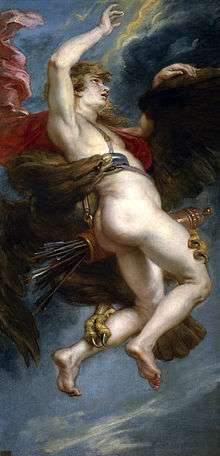Eros paidikos
Pederasty in ancient Greece was labelled Eros paidikos.

History
According to modern studies, pedagogic pederasty (Eros paidikos, παιδικός ἔρως) is thought to have been introduced around 630 BC. Crete is regarded as the birthplace of eros paidikos.[1] By the end of the 5th century BC, after the middle of the Archaic period, myths about love relationships between male gods and male heroes become more and more frequent, while poets had assigned at least one eromenos to every important god except Ares and to many legendary figures (Previously existing myths, such as that of Achilles and Patroclus, were also cast in a pederastic light).[2] The institution has its roots among the Dorian Greeks, where it was a recognized institution.[3] According to Plato the Dorians were the first who even gave a pederastic meaning to the myth of Ganymede.[4]
In Sparta, the relation between the erastes (εισπνήλας was the Spartan word) and the eromenos (αΐτας) was not only legal but required by law, and the erastes was regarded as a guardian of the eromenos and was held responsible for any wrongdoings of the latter.[1] Researchers of the Spartan civilization, such as Paul Cartledge, remain uncertain about the sexual aspect of the institution. Cartledge underscores that the terms "εισπνήλας" and "αΐτας" have a moralistic and pedagogic content, indicating a relationship with a paternalistic character, but argues that sexual relations were possible in some or most cases. The nature of these possible sexual relations remains, however, disputed and lost to history.[5]
References
- I. Sykoutris, Introduction to Symposium, 43
- W.A. Percy, Pederasty and Pedagogy in Archaic Greece, 54
- I. Sykoutris, Introduction to Symposium, 41
- Plato, The Laws, 636c
- P. Cartledge, The Spartans, 272-274